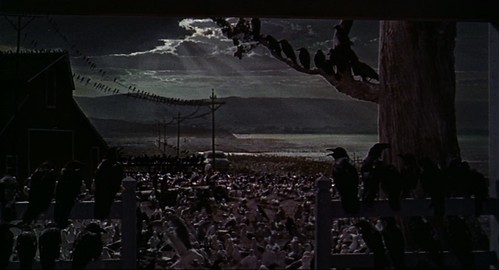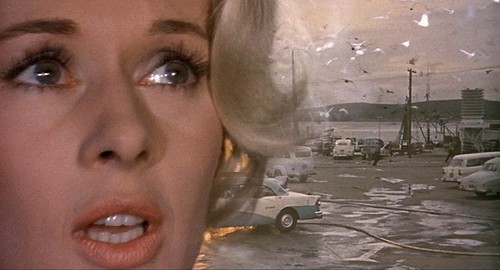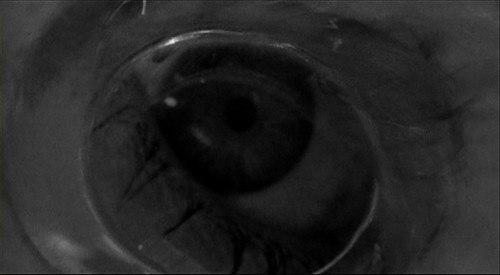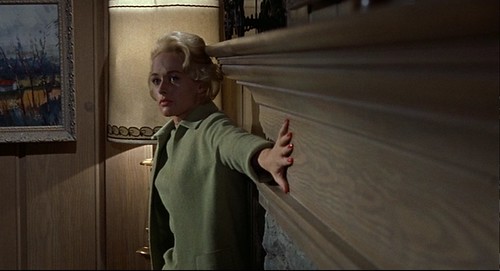Psycho begins by focusing the audience's attention on Marion Crane. The first time we see her, she's in bed with only her bra. The hotel room is dark and her underwear is white, creating a contrast that brings the focus on her. Especially in 1960 but even today, our attention is immediately drawn to her sexuality because she's undressed and displayed on the bed. The scopophilic gaze is particularly potent here, since the audience is allowed to watch Marion in an intensely private situation. She is having an affair with Sam and tells him it's the last time she's "meeting you in secret so we can be secretive." By letting the audience listen in on these private conversations, the movie is guiding us to identify with Marion and see things from her perspective.
Laura Mulvey's essay "Visual Pleasure and Narrative Cinema" brings up this idea of The Male Gaze: pleasure from looking at women through identification with male characters. In the first part of Psycho, however, we identify with Marion's perspective because men looking at her are portrayed as repugnant or intimidating. When Marion goes to work, she meets the wealthy rancher Tom Cassidy. When Tom enters, he quickly hones in on Marion, sits on her desk and starts flirting with her. The audience does not identify with Tom because he speaks crudely and uncharismatically. He tells Marion: "You know what I do with unhappiness? I buy it off… Are, uh, you unhappy?" He is not very subtly, trying to pick her up as if she's a call girl or prostitute. The Male Gaze doesn't apply to this situation because Tom is not very identifiable. The audience is supposed to be repulsed by him, and he almost deserves to be robbed.
The audience doesn't identify with the policeman either. While it's true the sunglasses make him anonymous like the audience, that anonymity generates fear rather than identification. In his close-up, he looks straight at the camera, placing the audience in Marion's point of view. In Marion's close-up, she's looking off-screen so we're not adopting his perspective. We get Marion's point of view so we naturally identify with her. There's also the simple fact that she's inside while he's outside. Like the movie theater, her car is an insulated environment providing a sense of safety. There is an intrinsic fear when that safety is breached because we are no longer anonymous. Part of the pleasure derived from scopophilia is our ability to watch without being watched. What the movie's doing is transplanting the audience to the protagonist's perspective and making us feel the pressure of being looked at.
The movie implants Marion with masochistic thoughts, which implicates us with sadism because we identify with her. As she's driving in her car, a voiceover runs through her head and she stares straight at the camera. In the voiceover, her boss, coworkers, and Tom talk about her crime. First, the boss and coworkers are heard, and Marion's face is pulled into a frown. As soon as Tom says: "I'll get [the money] back and if any of it's missing I'll replace it with her fine soft flesh," Marion's face changes to an ambiguous expression. It's not quite a frown, not quite a smile, but a mixture of both. Up until this point, Marion had been consumed by fear alone. But as soon as the thought of Tom wanting to abuse her comes in, a hint of happiness emerges. The simultaneous fear and exhilaration of her crime mirrors the audience's fear and exhilaration when watching the murders later on. We are partaking in a crime of sorts, when we find murder just as pleasurable as it is scary.
The movie goes to great lengths putting the audience in Marion's perspective and focusing the attention on her. Yet it gives a multitude of hints foreshadowing her demise and more importantly, a sudden shift in the narrative's perspective. When she's in her apartment about to steal the money, her bathroom is seen in the background which foreshadows the shower scene. She also changes into a black bra. While it's possible to read her costume change as a morality shift, there is a more definitive, less ambiguous reading. Simply, the black bra signifies her impending death within the narrative. It is because she steals the money that she ends up at the Bates Motel. When she arrives at the Motel, the movie already shows signs that it's shifting its focus away from her. When we first see Norman coming out of the house, for instance, we cut to Marion inside her car honking the horn. It's raining and water blurs her face. This not only foreshadows her murder, but it also shows a shift in focus; she is no longer the subject we're interested in, so the movie literally washes out her image. Finally, when we see her unpack in the motel room, there are pictures of a maple leaf and an oak leaf in the background. These leaves bring to mind Autumn, and signify Marion's Fall within the narrative.
The shower scene severs the audience's link with Marion and implicates us with her murder. Part of what makes the scene scary is its ability to surprise even after multiple viewings, revealing new details we never noticed before. I've seen the movie many times for instance, and I thought I knew what to expect: As Marion takes a shower, the door opens silently, a figure walks forward pulling the curtain back, and a faceless "Mother" proceeds to stab her. What startled me this time was discovering "Mother" is not actually faceless. Or rather, her face is not featureless. When she pulls back the curtain, we can actually see her eyes staring straight at us from Marion's point of view. The movie then cuts back and forth, placing the audience in both the position of the victim as well as the killer. When the scene ends, we are no longer seeing Marion's perspective but looking at her from the killer's position, implicating us as a guilty party. As she slides down the tiled wall, she reaches indiscriminately for the camera, then pulls the curtain down. Then we see a shot following Marion's blood to the drain, which looks like a lidless eye staring at the camera. The curtain is pulled, Act I has ended, and our view of Marion's perspective goes down the drain. The final shot of Marion is a dissolve from the drain to her eye staring straight at the camera. The camera is no longer interested in Marion's perspective so it pulls away, turns its attention to the money, and then to Norman.
Psycho focuses the audience's attention on Marion, invites them to identify with her perspective, then pulls the rug from under them. The movie presents an awareness of the camera, especially in the shower scene. There are too many eyes staring at the audience and too many point of view shots to ignore: Mother looking at the audience and stabbing them from Marion's point of view, the audience looking at Marion and stabbing her from Mother's point of view, Marion reaching for the camera as she slides down the shower wall, the unblinking gaze of the drain staring straight at us, and finally, the dissolve to Marion's eye, frozen on the camera as it retreats from her. All these shots combine to point at the audience and ultimately, put them in the position of the murderer. If there is one undisputed explanation for Marion's murder, it is this: She is killed because that's what the audience wants, and a movie named Psycho was made to give them that. Psycho depends on the shower scene more than any other, not only because it's what audiences relish the most, but because it points at them for it.
Like Psycho, The Birds focuses the audience's attention on its blonde female lead. Yet Melanie Daniels differs from Marion Crane because she likes being watched, at least in the beginning. In the very first shot, we see Melanie walk across the street, onto the sidewalk and then a person whistles at her. She is not repulsed, but simply smiles. Similarly, we see Melanie get on the elevator to deliver the lovebirds and hold a pose for the man standing next to her. As she gets out of the elevator, her eyes dart to the side, indicating she's fully aware of being watched. Her expression is not one of fear, but one that revels in the attention she's receiving. It's worth noting that the movie does not employ The Male Gaze here because we don't identify with the man and he doesn't give the impression of a fetishistic gaze. He simply looks at Melanie with minor curiosity and their dialogue is matter-of-fact and functional. Melanie relishes when people look at her and more importantly, the camera.
Melanie is very much on display, and in the beginning, she's not ashamed of it. When Mitch returns the canary to its cage in the pet shop, he says: "Back in your gilded cage, Melanie Daniels." The golden cage parallels Melanie's blonde hair and suggests her persona is a kind of cage or shell. Her appearance is almost a complete reversal to Annie Hayworth’s when they first meet. Annie is brunette, has a smudge of earth on her face, wears red, and has messy hair. Melanie, on the other hand, is blonde, has a clean, manicured look, wears green (the opposite color of red) and has neatly groomed hair. Melanie has a very refined look that she cares about the way she looks. Yet her appearance does not necessarily say she's weak or dainty. In fact, she is assertive and has little shame in driving to Bodega Bay, trespassing into the house of a person she met a day ago, and leaving a gift of two lovebirds for a girl she's never met.
As the movie progresses, Melanie's groomed persona begins to crack and her assertiveness begins to disintegrate. The birds are the physical force chipping away at Melanie's persona. After the first seagull attacks her, Mitch dabs peroxide on her head, suggesting her blonde hair isn't natural, but bleached. Likewise, Lydia wraps her head in bandages after she's attacked upstairs. Her trim and tidy hair also becomes messier whenever the birds attack her. This places an emphasis on the fragility of her physical appearance, which mirrors the frailty of her persona. Melanie seems to relish the attention she receives in the beginning, but grows to resent and eventually fear it. The negative attention she gets pecks away at her psyche, just as the birds peck at her body. When she's invited to the Brenner's, Lydia tells Mitch: "She is the one who jumped in a fountain in Rome last summer, isn't she?" This seems like a reference to the Trevi Fountain scene in La Dolce Vita (made just two years earlier). That movie dealt with celebrities under the ubiquitous, almost vulture-like watch of the paparazzi. Similarly, Melanie is ashamed of her distorted image through the media, just as she is ashamed and frightened of the birds that physically chip away at her.
Melanie alternates between the role of passive spectator and active spectacle; a role reversal that is mirrored by the birds. When she approaches the Brenner house by boat, she cuts off the engine and becomes a voyeur waiting for the Brenner's to leave. Then she becomes active, essentially trespassing into their home to deliver the birds. When she's in their house, she even looks out their rear window to the garage. Then she gets back on the boat and reassumes the position of the voyeur. Yet her blonde hair doesn't make it easy to hide, and when Mitch sees her through his binoculars, she's once again the spectacle. The birds' cycle of violence and passivity is reciprocal to Melanie's own. Birds are usually thought of as harmless creatures, like spectators watching us from power lines, buildings, trees, or cages. Yet in The Birds, they cast aside this role and force humans into watching from passive vantage points. This is best seen in the bird attack on the restaurant and gas station. One bird knocks out the gas station attendant and gasoline flows across a parking lot. A group of people, including Melanie, are huddled by the restaurant window and see a man light a cigar. Yet their muffled cries of warning are ultimately in vain. As the gas ignites, there is a montage of cuts between the scenery outside to Melanie in the restaurant. Each shot of Melanie is a frozen reaction, emphasizing her helplessness in the spectator's role.
The birds are a diegetic manifestation of the audience, implicating us with a gaze that traps the characters. During the bird attack on the gas station and restaurant, the women are huddled inside. When Melanie re-enters, one woman accuses her of causing the attacks: "Why are they doing this? They said the whole thing started when you got here." We see this from Melanie's point of view. The woman stares straight at the camera and is really accusing us. While it's true the attacks started when Melanie arrived, it's also true the attacks started when we arrived. We have always accompanied Melanie, and she is trapped by our gaze. When Melanie and the Brenner's are trapped in their own home, there is a shot of Melanie sliding along the wall with the camera following her. She now fears the camera but she can't escape from it. Just as the Brenner’s and Melanie are trapped in the house, they are trapped by the movie screen's frame and our gaze.
The scene where Melanie is attacked upstairs functions similarly to the shower scene in Psycho to place in the role of the killer. Melanie hears a noise upstairs and opens the door. It's only after she shines the light on the birds that they start attacking and she's trapped. The light is the stimulus for the attack, and it's as if Melanie's light is a movie projector conjuring up the attack. The camera cuts between Melanie's perspective and the birds, but the birds' perspective is dominant: We look down at her from a high angle and the birds’ point of view is more frequent. The focus is on Melanie, and just as the birds are pinning her against the door, so too is our gaze trapping her in the frame. When she is finally pulled out, we see her leaving the room but the scene ends with us on the birds' perspective. The final shot also leaves us in the birds' position: As the Brenner's drive into the light, we are left in the dark, surrounded by anonymous, homicidal spectators.

Both The Birds and Psycho focus the audience’s attention on their female lead and implicate us with a sadistic gaze. The inexplicable nature of the attacks in both movies denies an easy, diegetic cause for the violence. The movies point at the audience, placing them in the role of the killer and pegging us with a murderous gaze. That we find these movies enjoyable and fascinating is an unsettling truth that suggests our voyeurism is not beyond reproach.



No comments:
Post a Comment